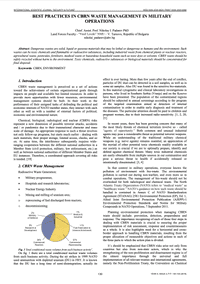Best Practices in CBRN Waste Management in Military Operations
[CBRN Waste Management]
This document outlines recommendations for the safe disposal and containment of chemical, biological, radiological, and nuclear (CBRN) waste in the context of military operations.
SUMMARY
This document outlines recommendations for the safe disposal and containment of chemical, biological, radiological, and nuclear (CBRN) waste in the context of military operations. CBRN waste may be toxic, flammable, or radioactive and may refer to agricultural waste, waste from chemical plants or nuclear reactors, pesticides, fertilizers, medical waste, or hazardous household products like toxic dyes or solvents. The authors suggest that there are several keys to a successful CBRN waste management plan including: understanding what wastes are hazardous; safeguarding waste throughout the collection, transportation, and disposal process; establishing procedures and standards for each aspect of the plan (segregate, collect, transport, recover, and dispose); assigning responsibilities appropriately; and creating the means to enforce standards through training, supervised execution, and inspections. The authors also stress the importance of strengthening the nation’s non-proliferation and disarmament regime, including the Treaty on the Non-Proliferation of Nuclear Weapons (NPT), the Chemical Weapons Convention (CWC), the Biological Weapons Convention (BWC), and the UN General Assembly Resolution 71/259 entitled “Treaty banning the production of fissile material for nuclear weapons or other nuclear explosive devices.” A coordinated waste management approach will also require cooperation between the national authorities of different Member States, including civil protection, military, and law enforcement.
This paper is written by Nikolay I. Padarev, an Assistant Professor within the Land Forces Faculty at the National Military University of the Republic of Bulgaria. It was published within Volume 2, Issue 3 of Security and Future, an international scientific journal covering the theoretical foundations of security, national and international security, information security, and technical facilities for ensuring security. Security and Future is one of nine scientific journals published by the Scientific-Technical Union of Mechanical Engineering, a national non-governmental professional union of scientists, engineers, specialists, and managers in the machine engineering field. The organization is based in Bulgaria and founded under the Law on Non-Profit Legal Entities. Its goal is to promote the principles of an “Industry-4.0 strategy” in the social, political, and economic life of different countries through academic and industrial partnerships as well as international scientific congresses and conferences. As of January 2022, this article appears to only be available in English.


..png)
